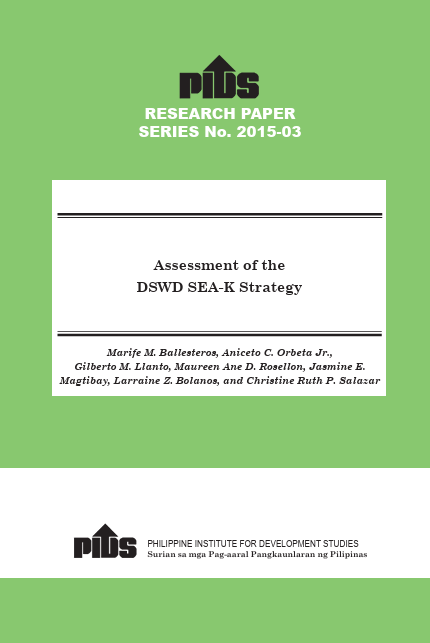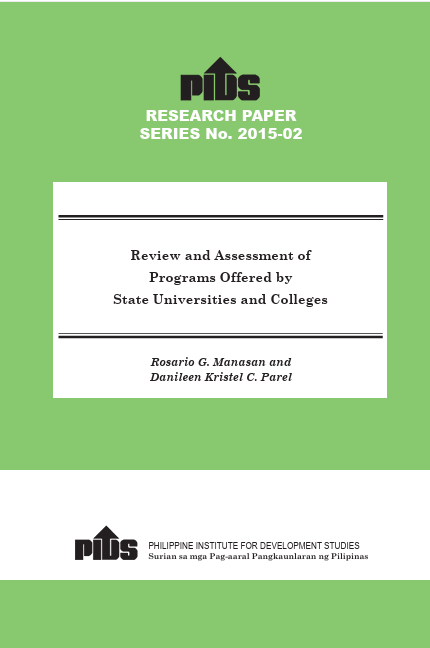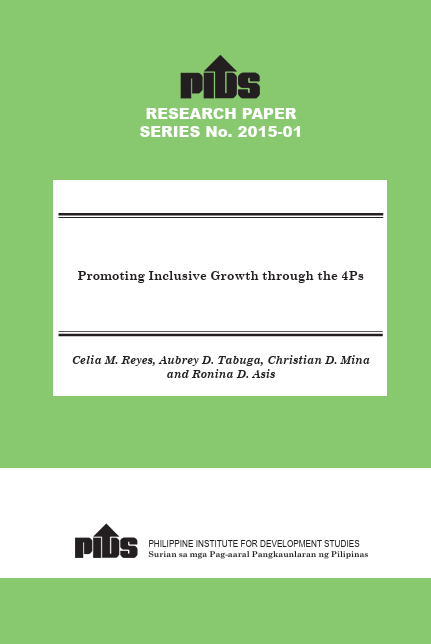PIDS 2015
The Research Paper Series are the final outputs of the research staff. The Series is a formal publication meant to promote research, stimulate discussion and encourage the use of study results. Studies published under this Series have been reviewed by an internal publications review committee and by external referees. Studies are original and have not been published in any form and contain the rationale, framework, methodology, conclusions or recommendations and other relevant information.
-Republic of the Philippines, PIDS
Abstract
This study assesses the effectiveness of the strategy and the complementary interventions of the Sustainable Livelihood Program’s Self-Employment Assistance Kaunlaran (SLP SEA-K). The SLP SEA-K uses a microcredit strategy to provide credit access to the poor, improve the ability of the group to borrow, and enable it to engage in income-generating activities. Microcredit services are generally believed to have a positive socioeconomic impact; however, the success of projects may depend largely on the management of the program. The authors found out that the government lacks the capacity to handle microcredit programs. Additionally, they see the one-size-fits-all strategy of the program as a problem because of the diverse range of beneficiary profiles.
Abstract
The state universities and colleges (SUCs) in the Philippines have always been a major issue mainly because of the poor quality of education that most of them offer, the undeveloped management and financial systems, and the inequality of access. And yet the government has been providing them considerable funding support (e.g., the budget allocation for FY 2012 amounts to PHP 26 billion) primarily due to the importance of tertiary education in promoting human development and improving the economy’s competitiveness. A review of the mandates of the various SUCs in the selected regions covered by this study indicates that the mandates are fairly broad, to start with. But beyond this, the charters of most SUCs allow them to offer programs outside of their core mandates. Given the broad mandates of SUCs, there is, therefore, a substantial duplication in their program offerings. The high rates of program duplication appeared to be associated with an increase in the number of programs offered by SUCs during the period. Although SUCs perform better than private higher education institutions (PHEIs) in over 84 percent of professional board examinations (PBEs), SUCs have been able to improve their advantage further relative to PHEIs in the last seven years in 31 percent of the PBEs; the edge that SUCs used to enjoy in the early part of the period has been eroded in over 69 percent of these PBEs. Perhaps what is more worrisome than the persistently low overall average passing rate in PBEs is the preponderance of SUCs/PHEIs with zero passing rates in many PBEs during 2004–2011. The study recommends that the Commission on Higher Education (CHED) enforces more vigorously its policy of closing existing programs of SUCs and PHEIs that perform under par year after year. There is also a need to improve CHED’s ability to ensure that the program offerings of SUCs comply with their policies, standards, and guidelines. To correct this unintended consequence of the normative funding formula, there is a need to adjust the formula so that SUCs do not get an additional subsidy from the national government for additional enrollment resulting from their program offerings. Finally, more effective measures to improve the quality of instruction based on evidence available to date include faculty development and facilities upgrading.
Abstract
The Pantawid Pamilyang Pilipino Program (4Ps) of the Philippines marks its fifth year of implementation in 2013 since its inception in 2008. The f irst batch of 4Ps beneficiaries will graduate from the program in several months while the government continues to expand its implementation, devising along the way several variants that it deems necessary to address the many facets of poverty. The 4Ps is by far the largest poverty reduction and social development program the Philippine government has ever implemented. Approximately PHP 120 billion have already been allocated to the program up to 2013. The program’s dual objectives are social assistance and social development. It provides cash assistance to poor families to alleviate their immediate needs and aims to “break the intergenerational poverty cycle through investments in human capital”. As program graduation nears, many questions arise as to what to expect from this program. At this point, it may be fitting to draw together assessments that have been conducted so far and to look into some important issues in terms of design and implementation. This paper seeks to answer the question of whether expanding the program would likely yield better results. It discusses the outstanding issues raised against the program, most especially those that bear on the program’s ability to facilitate inclusive growth.


